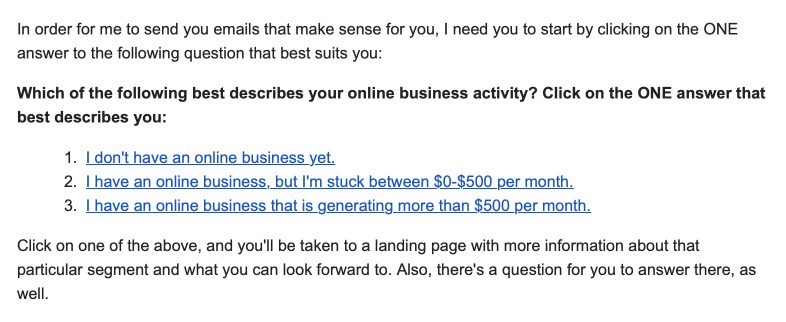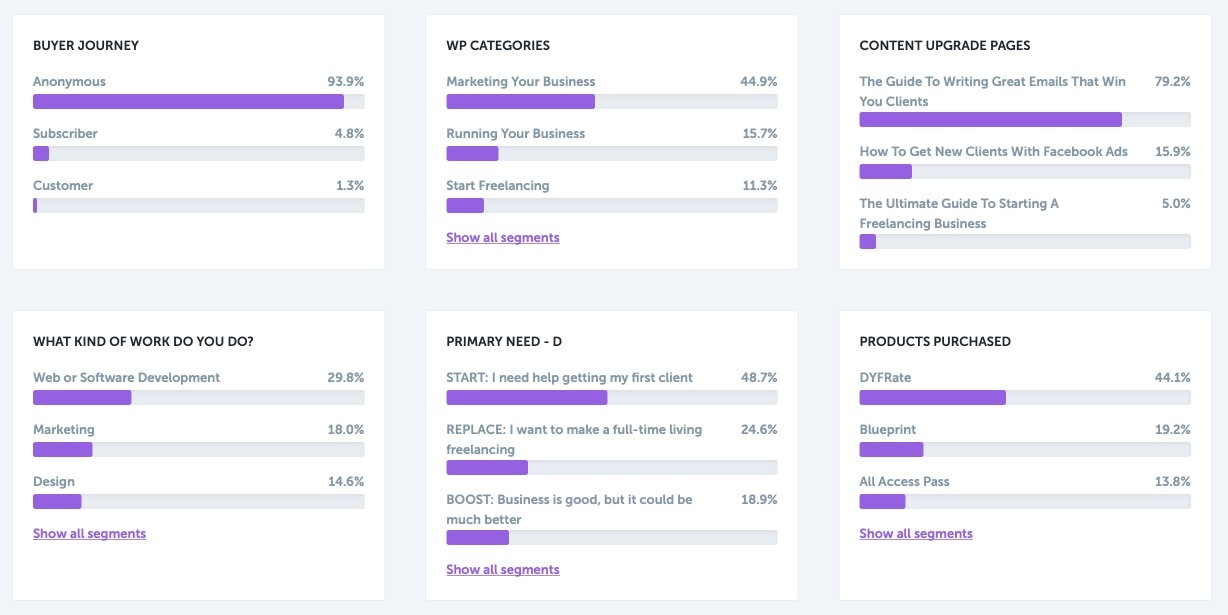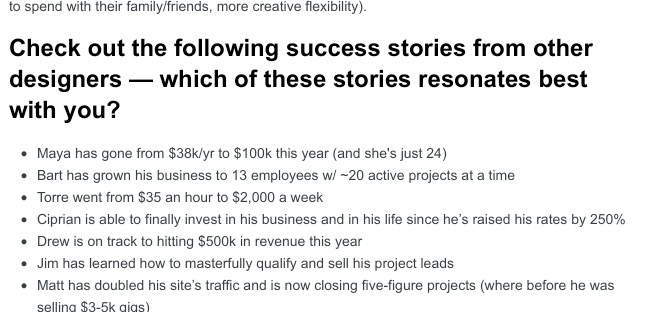“The money is in the list.”
Hang around email marketers long enough, and you’ll hear a lot of talk about list size, open rates, click rates, and a bunch of other stats that really only register with those who live and breathe email.
These same email marketers are also the first to tell you how invaluable a list is. Compare the ROI of email marketing to paid ads, social media, and other digital marketing channels and the results are clear: email can make you a lot of money.
There are probably quite a few different ways for someone to join your email list.
Maybe you’re just building an interest list of asking people to join your newsletter. There’s likely no real expectation outside of future stuff – future emails, a future product release, etc.
And on the other end of the spectrum, you’re incentivizing people onto your email list by offering a transaction: Give me your email address, and I’ll give you this valuable thing. This might be an email course, a content upgrade, a free ebook, a live webinar, or something else.
Regardless of how you’re getting people onto your list, delivering a world-class experience is a must.
List onboarding is how you do that. Sometimes described as a “welcome sequence”, this is just a sequence of emails that introduce someone to you, your content, and your mission.
Here are 6 musts for delivering an incredible onboarding experience for your subscribers:
Either before or immediately after someone joins your email list, find out a bit about who they are and what they need from you.
If you’ve read our guide to thank you page segmentation or you’ve recently joined our free email course, you’ve seen this in action.
By capturing this data, you’re able to accomplish two really important things:
Most lists are one-size-fits-all. But by making it clear that you want to better understand the unique identities and needs of your subscribers, you’re stating that you know how important it is for them to be heard – and, most importantly – given exactly what they need (and nothing more!)
If someone joins your list and tells you that they’re contemplating starting a new business and that they’re a great baker, you can do a lot with that information.
From showcasing other bakers who you’ve helped, or by prioritizing the content or products you’ve created that help aspiring business owners, you’re able to help people think less. Time and attention are at a premium, and if your new subscribers ever need to think “…why am I getting this article about scaling an agency… I haven’t even started a business yet!” then you’re likely to lose a bit of trust with them.

You can also survey people using link triggers in your welcome emails. Above is an example of how Pat Flynn at Smart Passive Income used to segment brand new subscribers (this was before he started using RightMessage!)
Did someone just tell you that they’re looking to start a new business?
Excellent!
Make that the focus of your first email to them.
When segmenting off someone’s primary need, there should really only be 3-4 options you give someone. Check out our guide to basic segmentation for a primer on how to come up these options.
And while it might seem initially daunting to create three or four variations for the first automated email you ever send someone, consider this:
Imagine you’re looking to start a business, and you believe that by joining so-and-so’s email list you’ll be able to do that faster or better?
How much more impactful would it be to have that first email focus entirely on starting a business, rather than having it be watered down with a bunch of random stuff about growing, selling, or whatever else people already running a business care about?
Make it a priority to come up with one unique email per need someone might have, and make your opening salvo 100% focused on letting people with that need know that you “get” them, and that you have a plan to help them.
After delivering your welcome email, consider how you can front load your best, most relevant content to your new subscribers.
Rarely does someone care about the “newness” of content. If you wrote a great email for entrepreneurial bakers a few years back, (re)sending that old email to a new subscriber is going to be a lot more valuable to them when compared to throwing them head-first into whatever you’re currently writing content about.
Think about how you can curate a great series of emails that are based on both who someone is and what they need. By delivering homerun after homerun to a new subscriber, they’re going to feel confident that they’re at the right place and on the right list.
Discrete segmentation – like this person wants to start a business, and that person is a baker – allows you to personalize content and see fun, high level stats about your audience composition.

But nothing compares to the sort of raw and visceral language you’ll get when you simply ask someone:
“I’m looking forward to helping you start your new baking business! Could you reply to this email with a bit more context on what led you down this path? I read and reply to every email I get.”
Starting conversions on autopilot, especially if you’re just starting out with your email list, is a great way to not only get to know your audience, but it also opens the door for a few back-and-forth’s that lead to coming up with that perfect next product or a better way of describing why someone should buy from you.
Almost all of the products and services I’ve created (including RightMessage) have been the result of keeping my ear to the ground and listening to what people had to say. And so, so many of these conversations started off as replies to automated emails.
Want to really impress your new subscribers?
Make it clear that you’re listening to what they told you, and then show off a few case studies or testimonials from people similar to them.

You might question why you’d want to drop testimonials so early on in a relationship. After all, you’re probably not trying to heavily sell someone on buying from you yet – right?
By showing a few relatable case studies, you’re making it clear that you’ve helped others like them in the past.
The one-two punch of “I’ve listened to what you said your problem is, and here’s how I can help… and I understand who you are, and here are others like you who have benefited from me” is massively powerful message to send.
And you simply can’t send messages like that without starting with segmentation.
When onboarding new subscribers, setting expectations around what you’ll send, why you’ll send it, and what their role is on your email list is key.
You’ve probably already sent them a sampling of the sort of content they can expect from you (see section #3), but it doesn’t hurt to continuously reinforce that.
Also, don’t shy away from telling people that you’ll be continuously trying to learn about them and their needs. You’re able to best serve someone when you know what they need. Let people know that you’re profiling them not because you’re some sort of Big Brother-ish data geek, but because you’re always working at giving the individuals on your list exactly what they need from you.
How do you make money? Sure, someone likely joined your list because you offered them something for free. But that doesn’t mean that you shouldn’t make it obvious early on that you’re running a business. (Check out our guide to opt-ins for some great examples of ways for getting people onto your list.)
Your free content isn’t low value. Rather, it’s probably something that people need digest, think through, and then act on – and often with a lot of effort.
At RightMessage, we teach people how to segment, personalize, and build a great email-first business online. Our “upgrade” is that it’s almost always better (and cheaper) to buy RightMessage than the alternative path, which is hiring a developer to write a lot of brittle code.
But for other companies, like those who sell online courses, the free content isn’t in any way inferior to the digital products they sell. Instead, the free content is likely less prescriptive. Less of a framework. Less complete. Fewer turnkey resources, like checklist, templates, and more.
By positioning your free content something with wide appeal that requires the reader to figure out how to act on, and your paid content as either more individualized and one-on-one (i.e. coaching or consulting) or more turnkey (like with a product company), then you’re not creating some weird and uncomfortable chasm between your free stuff and your paid.
This is something that took me initially off guard, but some of your readers might not realize that you want them to share what they’re reading of yours with others.
I remember once getting an email from someone who read one of my latest blog posts I emailed my list about. The gist of her reply was, “I really liked this. Would you mind if I shared it with a few people?”
Of course!!!
Help me virally grow my email list? Why would I ever say no to that?!?
Make it clear that you want people to share your content. Position your email list not as a one-to-many megaphone, but rather a two-way conversation. When your subscribers feel like you’re always trying to get to know them better, they’re going to feel like they’re a part of something bigger than any one person or brand.
The best referrers are always word-of-mouth recommendations, so don’t be afraid to let people know that – yes – they can (and should) share your content with their network.
There is. It’s right now.
No matter how small or new your email list, you want to make sure that those all-important initial emails show people that you’re listening, you’re responding, and that you’re here to help.
When you’re starting out, you’ll want to optimize for direct email replies. At scale, this might not be something you can sustain.
But, regardless of how big your brand or how many new subscribers you get on a daily basis, make sure you at least have a handful of introductory emails that implement what I covered above.
Start each and every new email relationship off on the right foot. And the best way to do that is through a well-crafted onboarding sequence.